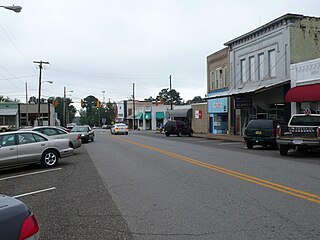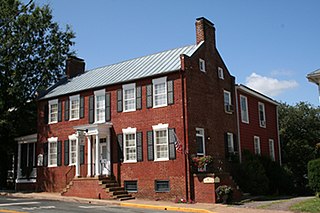
The David Rinehart Anthony House, also known as the Wynne House, was a historic vernacular Greek Revival style house in Eutaw, Alabama. The house was a two-story wood framed building on a brick foundation. Four octagonal columns spanned the front portico. It was built in 1860 by David Rinehart Anthony. It was added to the National Register of Historic Places as a part of the Antebellum Homes in Eutaw Thematic Resource on April 2, 1982, due to its architectural significance. It has since been destroyed.
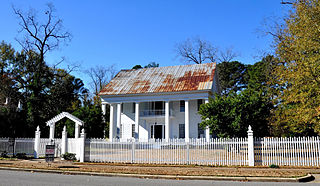
The Dr. Willis Meriwether House, also known as the Clark-Malone House, is a historic vernacular Greek Revival style house in Eutaw, Alabama, United States. The house is a two-story wood framed building on a brick foundation, six square box columns span the front portico. It was built in 1856 by Dr. Willis Meriwether. The house was recorded by the Historic American Buildings Survey in 1934. It was added to the National Register of Historic Places as a part of the Antebellum Homes in Eutaw Thematic Resource on April 2, 1982, due to its architectural significance.

The William Perkins House, now known as the Freemount, is a historic Greek Revival style house in Eutaw, Alabama, United States. The house is a two-story wood framed building on a raised brick foundation, four monumental Ionic columns span the front portico. It was built in 1850 by William Perkins on the Eutaw Town Square. The house was recorded by the Historic American Buildings Survey in 1934. It was added to the National Register of Historic Places as a part of the Antebellum Homes in Eutaw Thematic Resource on April 2, 1982, due to its architectural significance. It is also listed on the Alabama Register of Landmarks and Heritage.

The Edwin Reese House, also known as the Reese-Phillips House, is a historic Greek Revival style house in Eutaw, Alabama, United States. The house is a two-story wood frame building on a raised brick foundation. Four monumental Ionic columns span the front portico. It was built from 1856 to 1859 by Edwin Reese. The house was recorded by the Historic American Buildings Survey in 1936. It was listed on the Alabama Register of Landmarks and Heritage on October 17, 1980. It was added to the National Register of Historic Places as a part of the Antebellum Homes in Eutaw Thematic Resource on April 2, 1982, due to its architectural significance.

The Asa White House, also known as the White-McGiffert House, is a historic house in Eutaw, Alabama, United States. It was built in 1838 by Asa White, one of Greene County's earliest settlers. Eutaw was established on property owned by Asa White. He conveyed 20 acres (8.1 ha) to the newly established county seat in 1838 for the building of a courthouse, civic buildings, and a commercial district. He then sold residential lots to individuals. His house is a two-story frame building. It was built in the Federal style and later altered with the addition of Greek Revival-influenced details. The house was recorded by the Historic American Buildings Survey in 1936. It was added to the National Register of Historic Places as a part of the Antebellum Homes in Eutaw Thematic Resource on April 2, 1982, due to its architectural significance.

The Coleman–Banks House, also known as the James Oliver Banks House, is a historic Greek Revival style house in Eutaw, Alabama, United States. It was built in 1847 by George W. Shauver. It was purchased by Rhoda Coleman in 1857 and then by James Oliver Banks in 1890. The house is a two-story structure with four monumental Ionic columns spanning the front portico. It features elaborate Greek Revival doorways in the central bay of the front facade. The house was recorded by the Historic American Buildings Survey in 1934. The Greene County Historical Society purchased the house in 1968. It was added to the National Register of Historic Places on December 18, 1970, due to its architectural significance.

The Catlin Wilson House, also known as the Murphy Dunlap House, is a historic Greek Revival style house in Eutaw, Alabama, United States. The one-story wood framed building was built in 1844. A pedimented front portico with four Doric columns covers the three central bays of the front facade. The house was recorded by the Historic American Buildings Survey in 1936. It was listed on the Alabama Register of Landmarks and Heritage on November 5, 1976. It was subsequently added to the National Register of Historic Places as a part of the Antebellum Homes in Eutaw Thematic Resource on April 2, 1982, due to its architectural significance.

The Gustave Braune House is a historic house at 236 Prairie Street in Eutaw, Alabama.

The Attoway R. Davis Home, also known as the Attoway Davis Cottage, is a historic house in Eutaw, Alabama, United States. The main block is a two-story I-house, built in 1817. It is the oldest surviving house in Eutaw. Directly in front of this main block is a two-room cottage, built in 1840. The rear of the cottage was later connected directly to the front of the main block. A physician built a one-room office on the grounds in 1850; it was later attached to the side of the two-room cottage. The house was placed on the National Register of Historic Places as part of the Antebellum Homes in Eutaw Thematic Resource on April 2, 1982, due to its architectural significance. It was restored by Ralph and Diana Liverman and now serves as a bed and breakfast.

Glenville, also known as the Jincy P. Glenn House, is a historic house in Eutaw, Alabama. The structure was built in the mid-1840s for Jincy Pride Glenn. She was born in Virginia in 1776. Jincy Glenn was the widow of Daniel Glenn of Union County, South Carolina. The house was placed on the National Register of Historic Places as part of the Antebellum Homes in Eutaw Thematic Resource on April 2, 1982, due to its architectural significance.
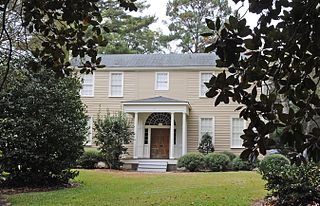
The Rev. John H. Gray House is a historic house in Eutaw, Alabama. The two-story frame I-house was built by John H. Gray in the 1830s. Gray served as the first minister for the First Presbyterian Church from 1826 until 1836. The house was placed on the National Register of Historic Places as part of the Antebellum Homes in Eutaw Thematic Resource on April 2, 1982, due to its architectural significance.

The Benjamin D. Gullett House is a historic structure in Eutaw, Alabama. The house was placed on the National Register of Historic Places as part of the Antebellum Homes in Eutaw Thematic Resource on April 2, 1982, due to its architectural significance.
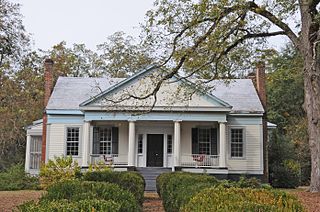
The Stephen Fowler Hale House, also known as the Hale-Jarvis-Trotter House, is a historic structure in Eutaw, Alabama. The house was added to the Alabama Register of Landmarks and Heritage on November 30, 1977 and subsequently placed on the National Register of Historic Places on April 2, 1982 due to its architectural significance. It is a part of the Antebellum Homes in Eutaw Thematic Resource.

The William C. Jones House, also known as the Archibald-Tuck House, is a historic structure in Eutaw, Alabama. The house was placed on the National Register of Historic Places as part of the Antebellum Homes in Eutaw Thematic Resource on April 2, 1982, due to its architectural significance.

The Samuel R. Murphy House, also known as the Winfield Scott Bird House, is a historic structure in Eutaw, Alabama. The one-story Greek Revival house was built in the 1850s by Samuel R. Murphy, in part with materials salvaged from the old Mesopotamia Presbyterian Church. It was purchased by Winfield Scott Bird in 1869. The house was placed on the National Register of Historic Places as part of the Antebellum Homes in Eutaw Thematic Resource on April 2, 1982, due to its architectural significance.

The Littleberry Pippen House is a historic house in Eutaw, Alabama. The one-story wood-frame house was built in the early 1840s. It features Greek Revival-style architecture, with inspiration drawn from Creole cottage forms. It was added to the National Register of Historic Places as part of the Antebellum Homes in Eutaw Thematic Resource on April 2, 1982.

The William A. Rogers House is a historic house in Eutaw, Alabama. The one-story wood-frame house was built in stages from the late 1840s to the 1850s. It features Greek Revival-style architecture, with a pedimented tetrastyle portico fronting the central three bays of the five-bay main facade. It was added to the National Register of Historic Places as part of the Antebellum Homes in Eutaw Thematic Resource on April 2, 1982.

The Iredell P. Vaughn House, also known as the Vaughn-Morrow House, is a historic house in Eutaw, Alabama. The one-story wood-frame house was built c. 1841. It generally conforms to the Creole cottage-type house plan, with neoclassical stylistic elements. A one-story porch spans the full width of the east and south facades. It was added to the National Register of Historic Places as part of the Antebellum Homes in Eutaw Thematic Resource on April 2, 1982. It currently serves as the headquarters of the Greene County Historical Society.

The William Peter Webb House is a historic house in Eutaw, Alabama. The two-story wood-frame house was built c. 1840. It is an I-house, with a Greek Revival-style distyle portico and other details added sometime later in mid-19th century. It was added to the National Register of Historic Places as part of the Antebellum Homes in Eutaw Thematic Resource on April 2, 1982.

The William B. Wills House, commonly known as Sipsey, is a historic house in Eutaw, Alabama. The one-story wood-frame house was built c. 1835. It is built in the Greek Revival style, atop a high brick foundation. A pedimented Doric portico spans the main entrance in the center of the five-bay main facade. The house was relocated in 1978 from 17 miles (27 km) northwest of Eutaw in order to preserve it. It was added to the National Register of Historic Places on September 22, 1983.

